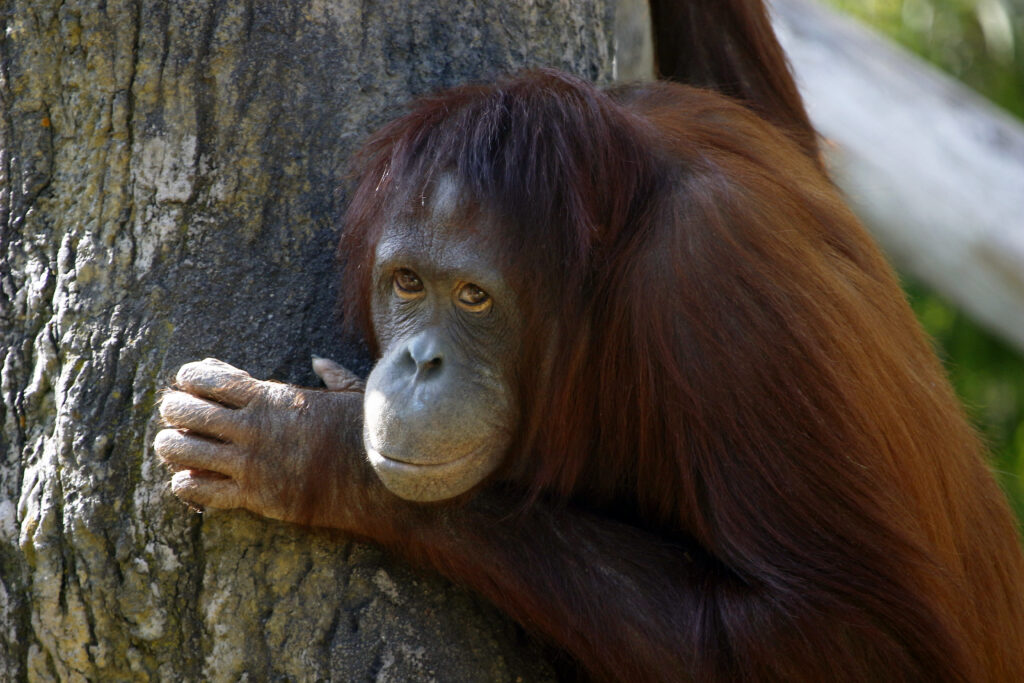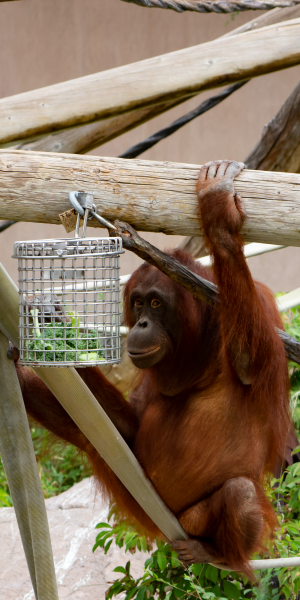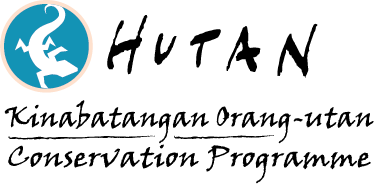You can help our conservation efforts by making a tax-deductible donation to Utah’s Hogle Zoo.
Utah's Hogle Zoo
Conserving Bornean Orangutans

Species' Stats
- Current Number in the wild: ~60,000
- Population Trend: Decreasing
- Location: Indonesia & Malaysia
- Animal Type: Great Ape
Why they Need our Help
There are three species of orangutan: Bornean, Sumatran and Tapanuli. Orangutans are found in the rainforests of Borneo and Sumatra in Southeast Asia. With over 500 different plants found in their diet, orangutans play a critical role in their tropical forest ecosystems.
Due to habitat loss from deforestation and unsustainable palm oil farming, orangutan populations are declining.


Our Work
Utah’s Hogle Zoo is a proud supporter of HUTAN Kinabatangan Orangutan Conservation Program, a French non-profit organization that is working to conserve Bornean orangutans in the Sabah region of Malaysia. Sabah is one of the only regions in the world where there is a good estimate of orangutan numbers in the wild. This is due to a series of comprehensive aerial surveys that were conducted in the early 2000’s. These surveys found that there were 11,000 orangutans in the state—approximately 1/5 of the global population.
Through our close partnership with HUTAN, Utah’s Hogle Zoo has been working to help the Bornean orangutan thrive in their ever-changing natural habitat. Projects include constructing bridges over rivers to mitigate deforestation, research how orangutans adapt to large palm oil plantations, and invest in community education.
The Orangutan Conservation Project
One of HUTAN’s first projects was the Orangutan Conservation Project, a grass-roots effort focused on conducting research. The goal was to study the survival of orangutans in degraded forests. A team of villagers was recruited to follow wild orangutans and record how they were adapting and surviving in fragmented habitats. The Orangutan Conservation Project is now one of the longest uninterrupted orangutan studies in Borneo accruing more than 25,000 hours of direct observation. Results have shown that orangutans can survive and even thrive in forests that have been exploited for timber if sustainable practices are followed. This conclusion is important because most orangutans exist outside of protected wilderness areas.

Orangutan Bridges
In their natural habitat, it is often necessary for Bornean orangutans to cross rivers and waterways in search of food. Old growth trees with branches and vines spanned these rivers in the past, facilitating orangutan crossings, but many of these natural “bridges” have been lost due to an increase in logging,
To address this issue, Utah’s Hogle Zoo partnered with HUTAN in 2003 to install the first man-made orangutan bridge over the Resang River leading to testing of multiple bridge designs using materials that range from old fire hoses to climbing webbing. These bridges are helping orangutans and other wildlife to thrive.
Orangutan Surveys and Monitoring
Effective conservation efforts involve species population monitoring. Orangutans are famously elusive and are only found at low densities throughout their range, making it difficult and time-consuming to track species numbers. Starting in the early 2000s, HUTAN developed a new method to survey orangutans using helicopters that have become common practice in orangutan monitoring. HUTAN is currently working to combine data gathered from these surveys with the data from nest surveys, interview surveys, and camera-trap surveys to gain insight into orangutan population size and trends.
Expanding Protected Areas
Based on the surveys done by HUTAN and the Sabah Wildlife Department, the local government increased the protected wilderness areas in the state from 12% to 26%. Our goal is to expand that percentage to protect 30% of the Sabah landmass.
In 2017, Utah’s Hogle Zoo purchased a monitoring vehicle for HUTAN and contributed necessary field gear for their rangers. We helped fund the planting of over 16,000 seedling trees along degraded habitat that will be used by orangutans as ecological corridors.
We look forward to continuing our partnership with HUTAN through the long-term study of orangutans on the Kinabatangan flood plain. Our goal is to aid in informed decisions making with sustainable palm oil plantation practices and the ongoing replanting of forests to secure orangutan habitat.
Sustainable Palm Oil
At Utah’s Hogle Zoo, we support the conservation of orangutans through the intentional purchase of products that are made with sustainable palm oil.
Palm oil accounts for 11% of Indonesia’s export earnings, with 1/3 of production attributed to smallholder farms. It’s an efficient crop that can be harvested year-round, yielding up to 10 tons of fruit per hectare. Palm oil requires ten times less land than the other three major oil-producing crops: soy, rapeseed, and sunflower.
Instead of boycotting palm oil altogether, it’s important to shop for products that source palm oil sustainably. In 2004, the Roundtable of Sustainable Palm Oil (RSPO) was founded to develop sustainable standards that palm oil growers and manufacturers could adhere to. Guidelines set by the RSPO include: no clearance of virgin rainforest from 2005 onwards, impact assessments on new infrastructure, and bans on the use of fire for land preparation or pest control.
Palm oil is incredibly versatile and is found in everything from food to beauty products. By purchasing sustainable products, you help to protect orangutans around the world. To purchase products that are made with sustainable palm oil, download the Sustainable Palm Oil Shopping Guide app from Cheyenne Mountain Zoo.
Partners
